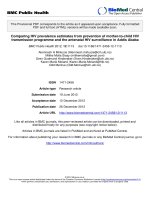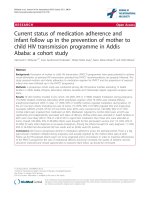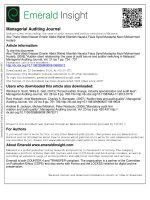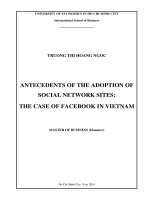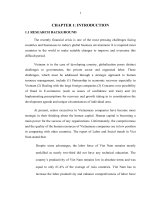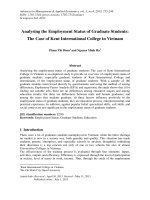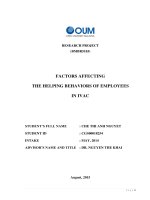Employment rights of female employees in the construction industry the case of bole arabssa condominium housing building project in addis ababa
Bạn đang xem bản rút gọn của tài liệu. Xem và tải ngay bản đầy đủ của tài liệu tại đây (1.59 MB, 149 trang )
Addis Ababa University
College of Law and Governance Studies
Center for Human Rights
Employment Rights of Female Employees in the Construction
Industry: The Case of Bole Arabssa Condominium Housing Building
Project in Addis Ababa
By
Estifanos Balew Liyew
Advisor
Meron Zeleke (PhD)
June 2017
Addis Ababa, Ethiopia
Addis Ababa University
College of Law and Governance Studies
Center for Human Rights
Employment Rights of Female Employees in the Construction
Industry: The Case of Bole Arabssa Condominium Housing Building
Project in Addis Ababa
By
Estifanos Balew Liyew
Advisor
Meron Zeleke (PhD)
A Thesis Submitted to the Center for Human Rights of College of Law and Governance Studies,
Addis Ababa University in Partial Fulfillment of the Requirement of the Degree of Master of Arts
in Human Rights
June 2017
Addis Ababa, Ethiopia
ADDIS ABABA UNIVERSITY
COLLEGE OF LAW AND GOVERNANCE STUDIES
CENTER FOR HUMAN RIGHTS
Approval Sheet by the Board of Examiners
Name: Estifanos Balew Liyew
ID No. GSR/0692/08
Title: Employment Rights of Female Employees in the Construction Industry: The Case of Bole
Arabssa Condominium Housing Building Project in Addis Ababa
Approved by Examining Board
Advisor
Signature
Date
Internal Examiner
Signature
Date
External Examiner
Signature
Date
Addis Ababa University
Declaration
I, the undersigned, declare that to the best of my knowledge this thesis is my original work and
that other works quoted in this thesis are duly acknowledged. This thesis has never been
submitted to this, or any other University for the award of a degree.
Declared by: Estifanos Balew Liyew
Signature___________________
Date_______________________
Confirmed by: Dr. Meron Zeleke (advisor)
Signature____________________
Date_______________________
i
Acknowledgements
This study has become realistic through kind and redoubles cooperation of individuals whose
support, encouragement and cooperation was vigor for me to make possible and spirited and
bestirred me to carry out this study without them that would not have been possible.
In this regard many thanks go to Dr. Meron Zeleke, my advisor, who is blissfully confirmed by
saying “I had time, interest and resource to help you on this issue - Employment Rights of
Female Employees in the Construction Industry” - when I asked her on the early inception of the
idea. As a result her continuous encouragement, tireless support, adroit advice, affable
communication and politeness was an encouragement for me to ask every points and enables to
pursue, and determination and strength for me from the inception up to the end. Because of this,
her incessant auspices to do this study were unreserved and without her knowledgeable guidance,
criticism and encouragement, it would not have realized.
I would also like to say many thanks to Dr. Sihen Tefera, my instructor of Gender and Human
Rights course, for giving me direction and guidance when I thought of this topic, also for her
encouragement, advice and support of me by scarifying time from her tight program.
I
would
also
like
to
thank
those
who
contributed
on
my
study
from
the beginning up to the end. Accordingly, great compliment deserves for my research informants
and government institutions that provided me all necessary information and data for the
accomplishment of this study, and my friends, especially Bezawit Bekele, who were around and
inspired me on the time of my weariness and to pursue this study.
I am so grateful of my family especially my mother and father who contributed for my education
from childhood until now; and rose and instilled in me courage to aspire high in life and follow
my dreams.
Above all, I would like to thank the Almighty God for giving me life, the brains and
opportunities to further my studies. Through your nourishment, protection and guidance anything
is achievable.
ii
Acronyms
AAHDPO
Addis Ababa Housing Development Project Office
ACHPR
Africa Charter on Human and Peoples’ Rights
ACHPRW
Protocol to the African Charter on Human and Peoples Rights on the Rights of
Women
ADLI
Agriculture Development Lead to Industrialization
ANRS-
Amhara National Regional State
AU
African Union
AUC
African Union Commission
AUGP
African Union Gender Policy
BPFA
Beijing Platform for Action
CA
Constitutive Act
CEDAW
Convention on the Elimination of All Forms of Discrimination against Women
CRC
Convention on the Rights of the Child
CSA
Central Statistical Agency
CSO
Civil Society Organization
DPFA
Dakar Platform for Action
EEA
Ethiopian Economic Association
FDRE
Federal Democratic Republic of Ethiopia
FGD
Focused Group Discussions
FWCW
Fourth World Conference on Women
GA
General Assembly
GAD
Gender and Development
iii
GBV
Gender Based Violence
GDAW
Gender Discrimination against Women
GDP
Growth Domestic Product
GEWE
Gender Equality and Women Empowerment
GTP-I
First Growth and Transformation Plan
GTP-II
Second Growth and Transformation Plan
GTZ
German Technical Corporation
HDPBO
Housing Development Project Branch Office
HDPO
Housing Development Project Office
ICCPR
International Covenant on Civil and Political Rights
ICESCR
International Covenant on Economic, Social and Cultural Rights
IHDP
Integrated Housing Development Project
ILO
International Labor Organization
LFPR
Labor Force Participation Rate
LSA
Labor and Social Affairs
MDGs
Millennium Development Goals
MoC
Minister of Construction Development
MoFED
Ministry of Finance and Economic Development
MoI
Ministry of Industry
MoLSA
Ministry of Labor and Social Affairs
MoUDH
Ministry of Urban Development and Housing
MoUDHC
Ministry of Urban Development, Housing and Construction
MoWCA
Ministry of Women and Children’s Affair
iv
MoWCYA
Ministry of Women, Children and Youth Affairs
NGOs
Non- governmental Organizations
NLFS
National Labor Force Survey
NPC
National Plan Commission
NPEW
National Policy on Ethiopian Women
OAU
Organization of African Unity
OHCHR
Office of the High Commissioner for Human Rights
ONRS
Oromiya National Regional State
OSH
Occupational Safety and Health
PFA
Platform for Action
PASDEP
Plan for Accelerated and Sustained Development to Eradicate Poverty
RECs
Regional Economic Communities
SDGs
Sustainable Development Goals
SDGEA
Solemn Declaration on Gender Equality in Africa
SDPRP
Sustainable Development and Poverty Reduction Program
SHINTS
Shin Textile Solution
SNNP
Southern Nations Nationalities and People
SNNPRS
Southern Nations Nationalities and People Regional State
SWCW
Second World Conference on Women
TGE:
Transitional Government of Ethiopia
TWCW
Third World Conference on Women
UDHR
Universal Declaration of Human Rights
UN
United Nations
v
UNDESA
United Nations Department of Economic and Social Affairs
UNDP
United Nations Development Program
UNHCR
United Nations High Commissioner for Refugees
UNEP
United Nations Environmental Program
UNICEF
United Nations Children’s Fund
UNIFEM
United Nations Development Fund for Women
UNPF
United Nations Population Fund
WAD
Women and Development
WDR
World Development Report
WID
Women in Development
vi
Table of Contents
Declaration ....................................................................................................................................... i
Acknowledgements ......................................................................................................................... ii
Acronyms ....................................................................................................................................... iii
Table of Contents .......................................................................................................................... vii
List of Figures, Maps, Photographs and Tables ............................................................................ xii
Abstract ........................................................................................................................................ xiii
Chapter One .................................................................................................................................... 1
1.
Introduction ............................................................................................................................. 1
1.1.
Background of the Study .................................................................................................. 1
1.2.
Statement of the Problem ................................................................................................. 3
1.3.
Objectives of the Research ............................................................................................... 9
1.3.1.
General Objective ..................................................................................................... 9
1.3.2.
Specific Objectives ................................................................................................... 9
1.4.
Research Questions ........................................................................................................ 10
1.5.
Significance of the Study ............................................................................................... 10
1.6.
Limitation of the Study .................................................................................................. 11
1.7.
Research Design and Methodology ............................................................................... 12
vii
1.7.1.
Research Methodology ........................................................................................... 12
1.7.2.
Research Methods ................................................................................................... 13
1.7.2.1.
Sources of Data ................................................................................................... 13
1.7.2.2.
Data Collection Tools.......................................................................................... 14
1.7.2.3.
Sampling Methods............................................................................................... 19
1.7.2.4.
Analysis of the Study .......................................................................................... 20
1.7.2.5.
Ethical Considerations......................................................................................... 20
1.8.
Organization of the Research ......................................................................................... 22
Chapter Two.................................................................................................................................. 24
2. Conceptual Frameworks and Literature Review....................................................................... 24
2.1. Conceptual Frameworks .................................................................................................... 24
2.1.1. Discrimination............................................................................................................. 24
2.1.2. Gender Discrimination ................................................................................................ 25
2.1.2.1. Gender ...................................................................................................................... 25
2.1.2.2. Gender Discrimination against Women ................................................................... 28
2.1.3. Employment Rights .................................................................................................... 29
2.2 Review of Relevant Literature ............................................................................................ 30
2.2.1. Female Employment and Discrimination against Women in Employment................ 30
2.2.2. Brief Note on Construction Industry and Women in Construction Industry .............. 32
2.2.3. Construction Industry in Ethiopia and Women’s Involvement .................................. 35
viii
2.2.4. Analytical Approaches to Women’s Employment Rights .......................................... 37
2.2.4.1. Economic Based Approach ...................................................................................... 38
2.2.4.2. Right Based Approach ............................................................................................. 39
Chapter Three................................................................................................................................ 42
3. Review of Relevant Legal Instruments ..................................................................................... 42
3.1. Relevant International Legal Frameworks ......................................................................... 43
3.1.1. United Nations Charter ............................................................................................... 43
3.1.2. Universal Declaration of Human Rights ..................................................................... 44
3.1.3. International Covenant on Civil and Political Rights and International Covenant on
Economic, Social and Cultural Rights .................................................................................. 45
3.1.4. Convention on the Elimination of all forms of Discrimination against Women ........ 46
3.1.5. The 1995 Beijing Platform for Action ........................................................................ 47
3.1.6. Convention on the Rights of Child ............................................................................. 48
3.1.7. Millennium Development Goals (MDGs) and Sustainable Development Goals (SDGs)
............................................................................................................................................... 48
3.1.8. International Labor Organization (ILO) ..................................................................... 49
3.1.8.1. Freedom of Association and Collective Bargaining ................................................ 50
3.1.8.2. Abolition of Forced Labor ....................................................................................... 51
3.1.8.3. Abolition of Child Labor ......................................................................................... 51
3.1.8.4. Discrimination in Respect of Employment and Occupation.................................... 52
ix
3.2. Relevant Regional Legal Frameworks ............................................................................... 52
3.2.1. Constitutive Act of African Union.............................................................................. 52
3.2.2. The African Charter on Human and Peoples Rights................................................... 53
3.2.3. The Protocol to the African Charter on Human and People’s Rights on the Rights of
Women in Africa................................................................................................................... 53
3.2.4. Solemn Declaration on Gender Equality in Africa ..................................................... 54
3.2.5. Africa Union Gender Policy ....................................................................................... 55
3.2.6. Dakar Platform for Action .......................................................................................... 55
3.3. Relevant National Legal Frameworks ............................................................................... 56
3.3.1. FDRE Constitution...................................................................................................... 57
3.3.2. Labor Proclamation No. 377/2003.............................................................................. 57
3.3.3. The National Policy on Ethiopian Women (NPEW) .................................................. 58
Chapter Four ................................................................................................................................. 60
4. Brief Background Introduction of the Study Area .................................................................. 60
4.1. Brief Note on the History of the Integrated Housing Development Program (IHDP) ...... 60
4.2. Description of Study Site: Bole Arabssa Site .................................................................... 62
Chapter Five .................................................................................................................................. 70
5. Female Employment Rights at Bole Arabssa Condominium Building Construction Industry 70
5.1. Status of Female Employment Rights at Bole Arabssa Condominium Building Construction
Industry ..................................................................................................................................... 70
x
5.1.1. Right of Female Employees’ before Employment and during Recruitment Process . 72
5.1.2. Working Conditions of Female Employees; Rights of Female Employees after Starting
Work ..................................................................................................................................... 79
5.2. Challenges and Risks of female employees in their everyday working life ...................... 96
5.3. Conclusion and Recommendations .................................................................................. 100
5.3.1. Conclusion ................................................................................................................ 100
5.3.2. Recommendations ..................................................................................................... 103
References ................................................................................................................................... 106
Appendix I .................................................................................................................................. 124
xi
List of Figures, Maps, Photographs and Tables
Table: 1.1 Backgrounds of Informants ………………………………………………………….15
Table: 1. 2 Background of Male and Female Member FGD……………………………………17
Table: 1.3 Background Female Members FGD………………………………………………….18
Table: 1.4 Profiles of Key Informants…………………………………………………………...19
Figure 4.1 Partial View of Bole Arabssa before it Designated for Condominium Building
Site……………………………………………………………………………………………….63
Figure 4.2 Bole Sub-city Map……………………………………………………………………65
Figure 4.3 Bole Arabssa Condominium Houses Building Project Site Map ……………………65
Figure 4.4 Organizational Structures of Main Stakeholder at Bole Arabssa Condominium Houses
Building Project …………………………………………………………………………………67
Figure 4.5 Completed Condominium Houses Building at Bole Arabssa Condominium Site…...68
Figure 4.6 Partial View of Condominium Houses Buildings on Construction at Bole Arabssa
Building Site……………………………………………………………………………………..68
Table 4.7 Ratio of female employees at Bole Arabssa condominium Houses Building Site in
Percentage………………………………………………………………………………………..69
xii
Abstract
This study evaluates and assesses the status of employment rights of female employees in
construction industry based on a case study conducted in Bole Arabssa condominium houses
building construction project site in Addis Ababa. There is no a research conducted on
construction industry female employee’s employment rights to study gender segregation.
Therefore, the basic objective of the study is assessing the status of employment rights of female
employees in the construction industry. The study analyses the existing different legal
instruments and policy frameworks that safeguarded rights of female employees. It addresses the
major challenges of female employees in the construction industry, the nature and root causes
for the violation of employment rights of female employees in the area, and lived experiences of
female employees at construction workplace.
The study used qualitative research method where different data collection tools were used
during the research. Both primary and secondary sources of data were used. The study has
explored, interpreted, and evaluated meanings, lived experiences of informants, collected
through interview, Focus group discussion, observation and informal talks. The findings of the
study point at the multifaceted violation of rights of female construction workers and the myriads
of challenges they face.
This study found that the practice employment rights of female employees in the construction
industry are far from what human rights documents supposed to. Violation of the right to work
(discrimination from employment such as segregation during employment and protection from
unemployment), violation of rights at work (violation of employment rights at workplace such as
wage discrimination, absence of maternity protection, health and safety protections) and job
insecurity and workload are violations of female employee’s basic employment rights that faced
them at workplace.
Key words: Employment rights, Construction industry, Female
xiii
Chapter One
1. Introduction
1.1. Background of the Study
Post 1991, Federal Democratic Republic of Ethiopia (FDRE) undertook various economic
strategies and policies to accelerate the economic growth of the country. Among these the
adoption of Agriculture Development Lead to Industrialization (ADLI), which is long-term
economic development strategy, as a national development plan in the mid 1990s is
mentionable.1 The country’s National Development Policy Framework is designed to eradicate
poverty.2 To meet this goal various medium and long-term plans and programs have been
designed since then. Some of these
are Sustainable Development and Poverty Reduction
Program (SDPRP) (2002/03-2004/05), Plan for Accelerated and Sustained Development to
Eradicate Poverty (PASDEP) (2005/06-2009/10), the First Growth and Transformation Plan
(GTP-I) (2010/11-2014/15) and the Second Growth and Transformation Plan (GTP-II) (2015/162019/20).3
The Ethiopian economy has registered a healthy economic growth rate since 2003/04.4 The role
of the industrial sector in the economy is significantly growing from time to time which implies
1
Arkebe Okubay. 2015. Made in Africa: Industrial Policy in Ethiopia. Oxford: Oxford University Press.P.63.
Kassahun Berhanu and Colin Poulton. 2014. “The Political Economy of Agricultural Extension Policy in Ethiopia:
Economic Growth and Political Control.” Development Policy Review 32 (2): 130-210. P. 200.
3
Arkebe Okubay, supra note 1, p.63.
4
Ibid, p.63.
2
1
the process of realization of the philosophy of ADLI- agricultural development is expected to
drive the process of industrialization.5
The construction subsector, which is one part of the industry sector, is leading in its contribution
to the economic growth in Ethiopia not only compared to other industry subsectors but also in its
contribution to the Growth Domestic Product (GDP) in general.6 Construction industry is often
believed to make significant contribution to the socio-economic development of a country7
having multiplier effect on other sectors even in the international level.8 The construction
industry is among the industries that are given top priority in the industrial development strategy
of 2013-2025.9 This is because construction subsector is capital and labor intensive, and it is the
base for other economic sectors.10 The disaffiliation of the Minister of Construction
Development (MoC) from the previous Ministry of Urban Development, Housing and
Construction (MoUDHC) - the current day Ministry of Urban Development and Housing
(MoUDH) - since September 2015 as an independent minister office in the country shows the
extent of the regard of the government towards the sector.
5
MoFED. 2010. Growth and Transformation Plan:2010/11-2014/15. Vol. I. Addis Ababa. P.4; FDRE Ministry of
Industry (MoI). September 2012. Ethiopian Industrial Development Strategic Plan (2013-2025). Addis Ababa. P.7;
Ethiopian Economic Association (EEA). 2015. Report on Ethiopian economy: current status of construction
industry. Addis Ababa: EEA. P.5.
6
Ethiopian Economic Association (EEA). 2016. Report on Ethiopian Economy: Current Status of Construction
Industry. Addis Ababa: EEA.p.6.
7
Ethiopian Economic Association (EEA). 2007. Report on Ethiopian Economy: Current Status of Construction
Industry. Addis Ababa: EEA. P.236; United Nations Environmental Program (UNEP). 1996. The construction
industry and the environment. Industry and Environment, volume 19 no. 2, Paris. It is estimated that one-tenth of the
global economy is bestowed to the construction sector. Construction industry has direct and indirect impact on the
national economy. Directly it creates job, accelerate national economy and serve as source of revenue. Indirectly it
facilitates other sectors and industries like cement factory, metal factories and corrugated iron (ceiling) factory etc.
8
MoC. 2016. Capacity Building Program Package of Construction Industry. Addis Ababa: MoC. P.3.
9
MoI, supra note 5, P.17. In the industry subsectors that gain top priory in the industrial development strategy are
Textile and Garment Industry, Agro Processing Industries, Construction Industry and Meat, micro and small scale
companies, Leather and Leather Products Industry.
10
Ibid.P.20.
2
The construction subsector plays a key role in creating employment opportunities in Ethiopia.11
As MoC stated that the total labor force in the construction industry makes up 12 percent of the
total labor force in the country.12 According to Central Statistical Agency (CSA) report females’
makeup 21.1 percent of the total labor force of construction industry.13 Given the fact that the
construction industry employs many unskilled labor forces and the temporary contractual nature
of the employment, female employees often face frequent challenges becoming imminent
victims of violations of rights. Though the construction industry is expected to be the engine of
economic transformation to meet the country’s goal of joining middle-income countries by 2025
through huge employment opportunity creation, there is no research done addressing the rights of
female employees of the construction industry which shows the gendered aspect of the sector.
Hence, this paper is aimed at assessing employment rights of female employees and working
environments in the construction industry of Addis Ababa city; and has explored the protection
given for female employees in the construction sub-sector.
1.2. Statement of the Problem
Women’s right to employment is one of the rights accorded to women under international,
regional and national laws. The right to employment is guaranteed for women like their male
counterparts without discrimination. The right to employment includes entitlements like equal
wage, freedom to choose one’s own profession, reasonable leave etc.14
11
EEA, supra note 7, P. 238.
MoC, supra note 8, P. 5.
13
CSA. 2014. National Labour Force Survey. Addis Ababa. P. 184.
14
UN General Assembly.1948. Universal Declaration of Human Rights. 10 December, 1948. According to UDHR
article 32(1) everyone has the right to work, to free choice of employment, to just and favorable conditions of work
and to protection against unemployment. UDHR also proposes more specific employment rights such as rights to
work, to form unions, to choose employment, to have safe and decent working conditions, to receive equal and fair
pay, and even to receive an annual holiday; International Covenant on Economic, Social and Cultural Rights (1966),
United Nations, Treaty Series, Vol. 993, p. 3. Entered into force on 3 January 1976. ICESCR on article 6 upholds
12
3
Likewise, according to CEDAW the right to employment is one of the basic women’s human
rights15 stating; “the right to work is an inalienable right of all human beings.”16 Women have
the rights to work as human beings and they must not be discriminated based on sex and women
have the rights to choose their profession and means of engagement. Accordingly, it says women
have “The right to free choice of profession and employment….”17 Equal payment right is also
basic rights of women inscribing that they shall enjoy freely without discrimination based on
their sex. This is clearly stated in CEDAW which proclaims that women have “the right to equal
remuneration, including benefits, and to equal treatment in respect of work of equal value, as
well as equality of treatment in the evaluation of the quality of work.”18
The right to employment of women is also enshrined in Ethiopian national laws. The FDRE
constitution states that “Women shall have a right to equality in employment, promotion, pay,
and the transfer of pension entitlements.”19 The labor proclamation No 42/93 which is amended
as labor law 377/2003 clearly specifies that women shall not be discriminated from employment
and equal payment based on sex and outlawed any discrimination against women.20 The law
also prohibited women’s employment on certain types of work that are considered to be harmful
everyone has the rights to work which includes the opportunity to choice one’s own profession including
appropriate safeguard from the state; African Charter on Human and Peoples’ Rights (1981). Entered into force on
21 October 1986. ACHPR every one has the right to work with favorable working environment and to receive equal
remuneration for the same work; FDRE HPR. 1995. Proclamation of the Constitution of the Federal Democratic
Republic of Ethiopia: Proclamation No. 1/1995. 1st Year No. 1. Addis Ababa-21st August 1995. The rights to
employment also stated under the Ethiopian constitution and labor proclamation No. of 377/2003. Hence, FDRE
constitution article 41(2) upholds as every citizen have the right to choose one’s own profession and livelihoods.
Labor proclamation No. 377/2007 elaborates detail employment rights of employee.
15
UN General Assembly, Convention on the Elimination of All Forms of Discrimination against Women.
1979. United Nations, Treaty Series, vol. 124, available at: />[Accessed 1 November 2016].
16
Ibid, Article 11(1) (a).
17
Ibid, Article 11(1)(c).
18
Ibid, Article 11(1)(d).
19
FDRE Constitution, Supra note 14, Article 35(1)(8).
20
FDRE Labor Proclamation No. 377/ 2003. Addis Ababa. Article 87(1).
4
for their health.21 The National Policy on Ethiopian Women was formulated in 1993 in order to
address problems related to discrimination against women.22 The Women, Youth and Children
Affairs a Minister (MoWYCA) - the current Ministry of Women and Children’s Affair
(MoWCA) is the leading agency working for the protection and realizations of equality rights for
women and children.
Even though, women constitute 49.6% of the total 7.3 billon world population23 and 50.08% of
the total 99 million populations in Ethiopia,24 they are not economically active as men, and are
often assigned to perform unpaid domestic works.25 This implies the persisting gender disparities
(even in rich countries);26 despite the fact that discriminations based on sex are outlawed in
various international, regional and national human rights instruments.27
In many developing countries, women face persistent discrimination in various forms enhancing
the challenge to realize women’s rights because the forms of discrimination are currently
21
Labor Proclamation, supra note 20, Article 87.
TGE. 1993. National Policy on Ethiopian Women. Addis Ababa, Ethiopia.
23
United Nations, Department of Economic and Social Affairs, Population Division. 2015. World Population
Prospects: The 2015 Revision, Key Findings and AdvanceTables. Working Paper No. ESA/P/WP.241. Available at:
www.esa.un.org.html[accessed on November 2, 2016]. P.1.
24
Ibid, P.14.
25
ILO.
2009.
From
Global
Employment
Trend
for
Women.
availabele
at:
103456.pdf.html. [
Accessed on June 28, 2016]; United Nations. 2015. The World's Women 2015: Trends and Statistics. New York:
United Nations, Department of Economic and Social Affairs, Statistics Division. Sales No.E.15.XVII.8. P. 99.
26
World Development Report. 2012. Gender Equality and Development, the International Bank for Reconstruction
and
Development
/
The
World
Bank.
Available
at:
[Accessed on October
27, 2016]. P.xxi.
27
UN Charter, Article 1 of the Charter stipulates that one of the purposes of the United Nations Organization is to
promote respect for human rights and fundamental freedoms “without distinction as to race, sex, language or
religion”(UN Charter, 1945(Article1)); UDHR, The Universal Declaration of Human Rights proclaimed the equal
entitlements of women and men to the rights enclosed in it, “without distinction of any kind, such as ... sex…”; The
International Covenant on Civil and Political Rights and the International Covenant on Economic, Social and
Cultural Rights prohibit discrimination based on, inter alia, sex (ICCPR, 1966(Article 2); ICESC, 1966 (Article 2)),
22
5
committed in a systematized manner.28 Women are underrepresented in skilled labor workplace
and they are over represented in an unskilled labor workplace and in the informal sector, which
is characterized by poor wages, insecure working conditions that make-up a violation of their
basic human rights of employment.29 Women tend to have less employment both in formal and
informal sectors of economy compared to men,30 and they faced discrimination on both sectors.31
Women in developing countries are highly engaged in industry outwork - lower industry
positions, house work and in unpaid family works.32
The problem of employment discrimination based on gender is also prevalent in Ethiopia.
According to the 2014 National Labor Force Survey (NLFS) the percentage of female employees
was 46.02 percent out of the total employed population.33 Female employees constitute 33.7
percent of formal employment sectors and 53.32 percent of the total labor force in the informal
sector out of this employed labor force.34 Though female employees constitute 53.32 percent of
the total labor force in the informal sectors, they earn lower payment as compared with their
male counterparts, they are highly concentrated at unskilled works, and they are victims of unfair
dismissal which is a violation of their basic human rights.35 This violation of basic employment
rights of women is prevalent in sectors like agriculture, construction, service and tourism sectors
28
Kinnear, Karen L. 2011. Women in Developing Countries: A Reference Hand book, ABC-CLIO. Available at:
[Accessed on November 28,
2016]. P. 27-29.
29
Ibid. P. 29.
30
Chen, Marty. 2008. Women and Employment in Africa: A Framework for Action: Background Document
commissioned by the Danish Foreign Ministry for the Second Conference of the Africa Commission in November
2008, Harvard University, WIEGO Network. Available at: />Chen Women-Employment-Africa.pdf. [Accessed on November 29, 2016).
31
Ibid, P. 2.
32
Ibid, P. 6.
33
CSA, supra note 13, P.182.
34
Ibid, P.262.
35
MoWCYA. 2013. Assessment of Conditions of Violence Against Women in Ethiopia. Addis Ababa: MoWCYA.
6
of the country.36 In Ethiopia 18.5 million people live in urban area which is not huge number as
compared with other African countries.37 Addis Ababa alone shares around 30 percent of the
total urban population of the country where most of the manufacturing industries are located in
or in the round of the city.38 However, there is shortage of house in the city to meet house needs
of the people lived in the city.39 Due to this there is high urbanization rate in Ethiopia which is an
average urbanization rate of 4.2% per annum,40 to meet the house needs of the people. Addis
Ababa city is designing huge housing development project to address housing problem of the
city since 2006.41 Hence, the Addis Ababa city administration is constructing houses in various
direction of the city. Among those Bole sub-city, on the south-eastern part of Addis Ababa, is
one that many government housing development program found there and target area for housing
development.
Construction workplace, which is the main focus of the study, is highly gendered workplace and
where employment discrimination against women is visible. Even though women constitute 21.1
percent of the total labor force in the construction sector at national level,42 16.5 percent of urban
construction sector,43 and 16 percent in building construction,
44
a large number of women are
involved in construction sites as laborers with huge loads with limited role as skilled worker in
construction sites,45 and faced discrimination.46
36
Ibid.
MoUDH. 2015. Growth and Transformation Plan (2015/16-2019/20): Sustainable Development and
Achievements Goals of Ethiopian Urbanization. Addis Ababa. P.18.
38
Solomon Keffa. 2014. Integrated Housing Development as Instrument to Alleviate Urban Poverty: The case of
Addis Ababa, (7359). Kuala Lumpur, Malaysia. FIG Congress. P.2.
39
Ibid, P.2.
40
Ibid, P.2.
41
Ibid, P.1.
42
CSA, supra note 13, P.182.
43
CSA. 2016. Report on the 2016 Urban Employment Unemployment Servey. Addis Ababa. P. 120.
44
Ibid, P. 148.
45
Ibid, P.149.
37
7
There are some pre-existing researches conducted on women’s employment to show the
discriminations of women and their segregation from mainstream economic activities. Abdi
Yuya (2008) studied gender earning differentials in the Ethiopian public sector by highlighting
women wage discrimination.47 Likewise, Gemechu Shale’s (2013) study addressed women’s
segregation from economic activities and how that hindered achieving the Millennium
Development Goals.48 Moreover, Esatu Gurmu (1994),49 Sagazaab Bazabeh (1998)50 and
Sebehat Daneél (1986)51
studied about women employment with a focus on the role of
employment to control fertility rate and family expansion. Salamawit Ababa (1994) dealt with
the role of women in the economic growth, their participation in the informal sector and the
challenges women face in the informal sector.52 Tsige Gebremichael (2016)53 also studied the
challenges women faced at workplaces of garment and textile factories. Tsige’s thesis explored
major challenges and opportunities to realizing the rights of female employees and employed a
human right approach inquiry based on qualitative research methodology.54
All the aforementioned works give little consideration to the rights of employment of female
employees in general and no attention to the lived experiences of female employees of the
46
Ibid, P. 201.
AbdiYuya. 2008. “Gender Earnings Wage Differential in the Ethiopian Public Sector,” M.Sc. thesis in
Economics. Addis Ababa. Addis Ababa: Addis Ababa University. Unpublished.
48
Gemechu Shale Ogato. 2013. “The Quest for Gender Equality and Women’s Empowerment in Least Developed
Countries: Policy and Strategy Implications for Achieving Millennium Development Goals in
Ethiopia.”International Journal of Sociology and Anthropology 5(1): 358-372.
49
Esatu Gurmu.1994. “Female Labour Force Status and Fertility in Akaki Sub-urban Industrial Town in Ethiopia,”
M.Sc. thesis in Geography. Addis Ababa: Addis Ababa University. Unpublished.
50
Sagazaab Bazabeh. 1998. “Women Employment in the Informal Sector and Fertility in Urban Ethiopia: The case
of AlemKetema Town,” senior paper in Geography. Addis Ababa: Addis Ababa University. Unpublished.
51
Sebehat Daneél. 1986. “Women Employment and its Impact on the Family: A Case Study of Akaki Textile
Factory,” senior paper in Sociology. Addis Ababa: Addis Ababa University. Unpublished.
52
Salamawit Ababa. 1994. “Women in Urban Informal Sector of Ethiopian Economy: A Case Study of Mercato in
Addis Ababa,” M.Sc. thesis in Economics. Addis Ababa: Addis Ababa University. Unpublished.
53
Tsigie Gebremichael. 2016. “Major Challenges and Opportunities of Realizing Rights of Employees: The Case of
Female Employees of SHINTS Textile and Garment Factory at Bole Lemi Industrial Zone.” M.A. thesis in Human
Rights. Addis Ababa: Addis Ababa University. Unpublished.
54
Babbie, Earl R. 2009. The Practice of Social Science Research, 12th ed. Wadsworth . P. 327-328.
47
8
construction sector. Drawing on the gaps identified in studies addressing the employment rights
of female employees and challenges in construction industry, this study has investigated
employment rights of female employees in the construction industry. Thus, the research
examined the theme by drawing on a case study of female employees of construction industry at
Bole Arabssa condominium housing building project at Addis Ababa.
1.3. Objectives of the Research
1.3.1. General Objective
The general objective of this research is to comprehend the employment rights of female
construction workers through a detailed study of lived experiences of female employees of Bole
Arabssa condominium housing building project at Addis Ababa.
1.3.2. Specific Objectives
This study has the following specific objectives;
Mapping out the different legal instruments and policy frameworks protecting rights of
female employees in the construction sector.
Examining the major challenges female employees face in the construction industry, if
any.
Identifying the nature and root causes for the violation of employment rights of female
workers in the industry
Understanding the working environment and working conditions at the construction
industry.
Recommending possible solutions for the realization of employment rights of female
employees at construction workplace.
9
